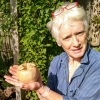Yes, I do use knives!
It's not that I cannot do it with carving tools but the knife seemed the best tool to carve the separate, little stalk. It's a Pfeil knife with a long thin blade. Watch the technique closely and in particular how I use my thumbs. You'll also see me deliberately leave a ragged end with my gouge. Gouges can sometimes worked like artists' brushes, creating a textured surface or edge.
I hope you've found this short introduction to carving in the round useful. Watch my approach. Make notes. Bear what I say in mind as you try something else. Something simple...

| 18 April 2020 15:11
Gary - A great idea - go for it! (And let's see it in the gallery…)

| 17 April 2020 19:16
Chris, Thank you for the nice demo on carving the apple. I just have one thought about the stem. What do you think of using walnut or another hard wood for the stem giving it a little more realistic look and also being a little stronger than basswood?
Thank you,

| 29 June 2019 16:17
I loved making this apple, although mine is definitely a Bramley. I learned so much as I went along and am really grateful for Chris's advice about switching hands, not rushing etc. It's my first ever 3D carving and I felt well guided with each step right through to the waxing I did yesterday. I knew I was improving when my carving actions sounded like Chris's.
I was wondering about making a smoother finish by sanding the apple and then decided that I wasn't making an apple, I was making a carving!

| 12 July 2015 07:15
Peter - Yes, you use gently heat, such as a hot water bathe to soften it the wax, the add some turpentine to keep it soft - beesax as the bees us it architecturally is hard. Carving Matters > Finishing > Wax x4 will reveal all... Using the hairdryer is just something I've worked out over the years. You can put the wax straight on with a brush or cloth - as you would polish shoes. It's easy to clog up the details with wax and the hairdryer keeps them clear. However, if you use several coats thin wax (more turps) rather than thick and use a brush on the details you should be able to keep the little crevices free of wax. But, you know, a simple hairdyer is really inexpensive, a secondhand one will do, and it might be worth investing in one as part of your carving equipment?

| 11 July 2015 18:58
Chris - Thank you for last answer
How do you soften Beeswax. I have a beeswax candle. By putting it in a metal or glass container and putting it in very hot water? ( as you suggested with the hardened wax)
I do not have a hair drier to melt the wax onto the apple, but I do have a wall mounted bathroom fan heater ( one setting) which I thought would do if hold the apple underneath it

| 07 July 2015 15:08
Peter - I've never trusted a microwave with inflammables such as wax or turpentine. You wax has gone hard because the turpentine has evaporated. Put your jar of hardened wax into a bath of very hot water, and it'll melt. Then add a little more turpentine to get the consistency you want. I've never bought proprietary wax polish but made my own. Look here: Carving Matters > Finishing > Wax x4 to see how. I use beeswax from bee keepers - beeswax candles that sort of thing. Quite inexpensive. The beeswax is 'soft' because I made it so. Generally I prefer soft wax for carvings to prevent wax congealing in the details.

| 07 July 2015 14:06
What beeswax did you use for your apple. I noted that you said it was soft. Did you buy it like that?
The beeswax I have,( that is now hard), is Lord Sheraton, Pure Beeswax BALSAM, Furniture Polish
If it cannot be restored to a working condition or consistency, what beeswax do you suggest I buy?
Thank you Peter

| 07 July 2015 13:36
Can you soften beeswax that has gone hard, say in the microwave perhaps, Or do I have to accept that it is unuseable.
It is quite a small amount, in the original glass jar, and the lid has been on ( or it was when I found it).
Peter